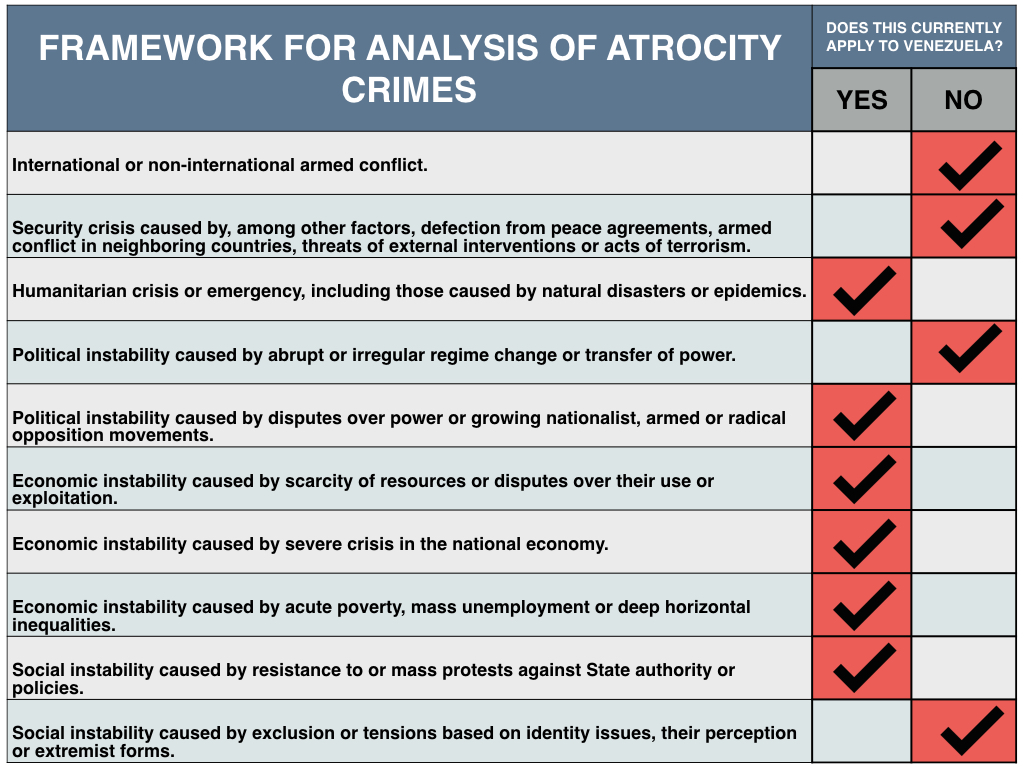Early warning signs of the unspeakable
You think we've faced the worst crimes? Think again. Necessary conditions for them to take place, however, do exist. We take a close look at how the United Nations thinks about these things.


Venezuelans are prone to exaggeration. We like to tell ourselves that we’re at, or near, rock-bottom, that things could not be much worse than they are. This, when you stop to really think about it, that’s very far from true.
Don’t believe me? Ask a Bosnian, or a Rwandan.
There are whole categories of human depravity Venezuela has not even flirted with yet. The very worst crimes —genocide, war crimes, and crimes against humanity— sometimes turn up as rhetorical flourishes in our politicians’ speeches, yes. But when we march, the Rhinocerontes spray tear gas on us, not Sarin.
Could that change? And if it did… how would we know about it?
A few days ago, a reader drew our attention towards the United Nation’s Framework for Analysis of Atrocity Crimes. It’s an official, bureaucratic document: in plodding, UN-speak, it lists the warning signs for the “big three”, the most serious international crimes: genocide, war crimes, and crimes against humanity.
Crimes against humanity encompass acts that are part of a widespread or systematic attack directed against any civilian population.
We cracked open the UN document with some trepidation. The introduction explains that each time a crime on this scale occurs, it is unique. But that doesn’t make them random: the warning signs are often there well ahead of time, if you know where to look for them.
The Framework establishes 14 different risk factors, eight of which are common to all atrocity crimes and the last six are specific risk factors (two per crime). The drafters warn these risk factors should be interpreted in the context of a given country’s political and historical background. Nothing is mechanical or automatic here: just like some people smoke a pack of cigarettes a day and live to a contented 97, some countries that pile on risk factors don’t end up witnessing atrocity crimes. Finally, the paper underlines, no risk factor is more important than the others. This is an instrument for qualitative analysis.
Each risk factor comes with a number of indicators; a high number of positive indicators means the risk factor probably applies to the country. For example, one risk factor is Situations of armed conflict or other forms of instability. Here’s our take on it:
Venezuela is not in the middle of a shooting war, but it does include six of the ten indicators for it as a risk factor. Our conclusion is that the Situations of armed conflict or other forms of instability risk factor does apply to the Venezuelan situation.
We kept on tackling these risk factors and their indicators with our most honest responses. We had to answer our most resounding Yes to indicators related to presence of civilian armed groups, large quantities of arms, and rampant impunity.
After assessing all 14 risk factors, we found that five of the eight general risk factors (see list below) apply to Venezuela. We also find that two out of two specific risk factors for Crimes against humanity apply to Venezuela.
But make no mistake, the responsibility to avoid atrocity crimes lies with the government
Risk factors for atrocity crimes in general that apply to Venezuela
- Situations of armed conflict or other forms of instability
- Weakness of State structures
- Motives or incentives
- Enabling circumstances or preparatory action
- Triggering factors
Risk factors specific for crimes against humanity
- Signs of a widespread or systematic attack against any civilian population
- Signs of a plan or policy to attack any civilian population
You can peek at our evaluation of individual indicators on this spreadsheet. Feel free to leave a comment there, if you disagree with our judgment.
Our final assessment? The country that not long ago was voted the happiest in the world now seems more likely than not to join the sad ranks of Holodomor (yes, Maduro, man-made famines are crimes against humanity).
If that doesn’t send a chill down your spine yet, you haven’t read the UN’s definition of what hopefully will not come to pass:
Crimes against humanity encompass acts that are part of a widespread or systematic attack directed against any civilian population. Even if non-civilians might also become victims of the attack, for an act to be considered a crime against humanity, the ultimate target of the attack must be the civilian population.
The Framework is clear: even if many risk factors are identifiable, that doesn’t make an atrocity inevitable. But make no mistake, the responsibility to avoid atrocity crimes lies with the government, as it is stated on the UN’s Responsibility to Protect initiative. The international community has committed to supporting countries in achieving this goal and is meant to take action if any state fails to do so.
Venezuela is not in the middle of a shooting war, but it does include six of the ten indicators for it as a risk factor.
As for ourselves, the citizens, let’s not let our guard down, and let’s inform everyone we can: the Venezuelan crisis has been escalating sure and steady. This year we’ve had a humanitarian health crisis, an economic crisis and, of course, a turmoil caused by political crisis, with the overall instability that follows it.
Let’s hope we’ve seen the worst already. Nobody wants an atrocity crime. Really, no one does.
Caracas Chronicles is 100% reader-supported.
We’ve been able to hang on for 22 years in one of the craziest media landscapes in the world. We’ve seen different media outlets in Venezuela (and abroad) closing shop, something we’re looking to avoid at all costs. Your collaboration goes a long way in helping us weather the storm.
Donate





